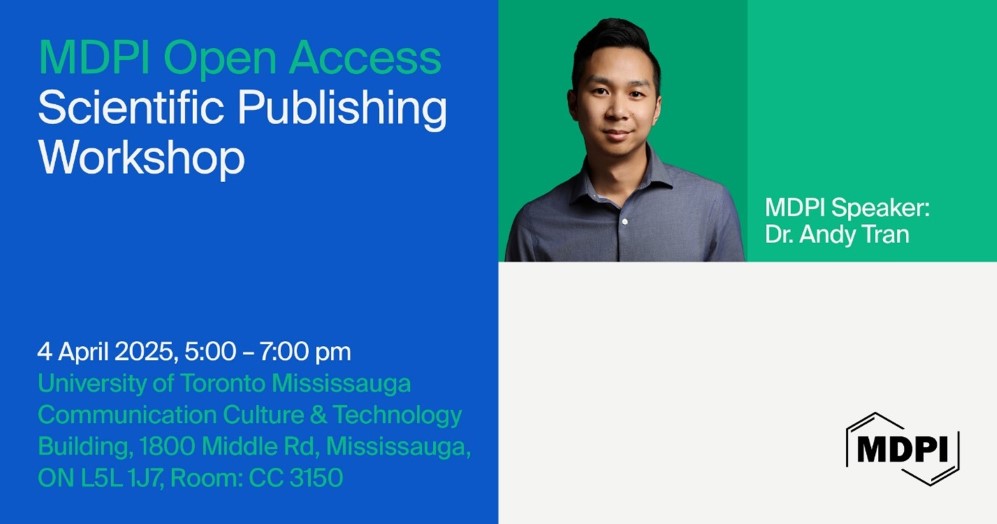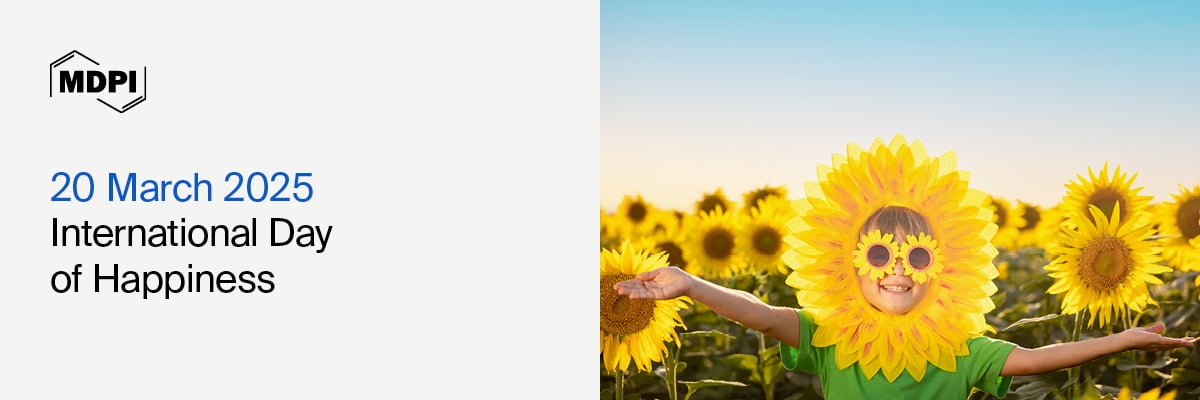Journal Description
Education Sciences
Education Sciences
is an international, peer-reviewed, open access journal on education published monthly online by MDPI. The European Network of Sport Education (ENSE) is affiliated with Education Sciences and its members receive discounts on the article processing charges.
- Open Access— free for readers, with article processing charges (APC) paid by authors or their institutions.
- High Visibility: indexed within Scopus, ESCI (Web of Science), Educational Research Abstracts, PsycInfo, and other databases.
- Journal Rank: JCR - Q1 (Education and Educational Research) / CiteScore - Q1 (Education)
- Rapid Publication: manuscripts are peer-reviewed and a first decision is provided to authors approximately 29.8 days after submission; acceptance to publication is undertaken in 3.8 days (median values for papers published in this journal in the second half of 2024).
- Recognition of Reviewers: reviewers who provide timely, thorough peer-review reports receive vouchers entitling them to a discount on the APC of their next publication in any MDPI journal, in appreciation of the work done.
Impact Factor:
2.5 (2023);
5-Year Impact Factor:
2.6 (2023)
Latest Articles
Learning Infant Development and Surveillance Through a Series of Board Games Designed for Psychology Students
Educ. Sci. 2025, 15(4), 457; https://doi.org/10.3390/educsci15040457 (registering DOI) - 7 Apr 2025
Abstract
Human development education often relies on traditional, lecture-based teaching methods, limiting opportunities for active engagement. The lack of diverse creative and active teaching approaches hinders psychology students’ ability to fully understand and apply complex concepts. This study examined the effectiveness of a designed
[...] Read more.
Human development education often relies on traditional, lecture-based teaching methods, limiting opportunities for active engagement. The lack of diverse creative and active teaching approaches hinders psychology students’ ability to fully understand and apply complex concepts. This study examined the effectiveness of a designed series of board games to enhance understanding of infant development and surveillance among psychology students. A mixed-method approach using a randomized matched control group design and qualitative exploration was applied. In the experiment, there were two groups, intervention and conventional learning, in three data collection phases. A design involving 60 students (30 in each group) was employed. The qualitative exploration involved the completion of a weekly journal to explore the students’ learning experiences when playing board games. A 2 × 3 mixed-design Analysis of Variance (ANOVA) with content analysis of the journal texts was performed. The results revealed that the created board games significantly enhanced students’ understanding, with them achieving significantly higher understanding scores in the posttest and follow-up phases in learning development progress. An interaction effect for the treatments and test phases was also noted. Meanwhile, the qualitative findings complemented and reinforced the quantitative results, offering deeper insights into the learning experiences and valuable suggestions for improving the design and rules of the games. In conclusion, by tailoring the board games to learning objectives associated with infant developmental psychology, educators can enhance student engagement, knowledge retention, and real-classroom application.
Full article
(This article belongs to the Special Issue Higher Education and Creativity: International Perspectives on Stimulating Student Engagement)
►
Show Figures
Open AccessArticle
Family Diversity from the Perspective of Early Childhood Education Students
by
Paula Peregrina-Nievas, María Jesús Caurcel-Cara, Emilio Crisol-Moya and Christian Cid-González
Educ. Sci. 2025, 15(4), 456; https://doi.org/10.3390/educsci15040456 (registering DOI) - 5 Apr 2025
Abstract
Family diversity is a reality in Spanish Early Childhood Education schools. However, there is little research on the perspective of teachers and families on this type of diversity, and even fewer studies on the viewpoint of children in Early Childhood Education. This study
[...] Read more.
Family diversity is a reality in Spanish Early Childhood Education schools. However, there is little research on the perspective of teachers and families on this type of diversity, and even fewer studies on the viewpoint of children in Early Childhood Education. This study analyzed the perception of family diversity among 156 Early Childhood Education children from three schools in the province of Granada (Spain). Alongside the use of the ‘Family Diversity Questionnaire for Children’, a quantitative study was conducted with a non-experimental, descriptive, cross-sectional, and comparative design. Descriptive statistics (mean, standard deviation, and mode) and frequencies were calculated. After assessing the normality of the data using the Kolmogorov–Smirnov test, inferential analyses were performed, using Student’s t-tests and ANOVA tests to determine whether there were any significant differences. The results showed that the nuclear family was the most recognized family structure by the children, in contrast to the one-person family, which was the least recognized. As for the happiness level, the extended family was identified as the happiest typology, while the divorced family was the one with the lowest happiness level.
Full article
(This article belongs to the Special Issue Cutting-Edge Research on Childhood Special Education)
►▼
Show Figures

Figure 1
Open AccessArticle
Institutional Compassion in Student Transition to University: Findings from the Nurture-U Compassionate Campus Project
by
Jemima Dooley, Vanessa Forbes, Amelia Green, Pranati Misurya, Polly Card, Felicity Thomas, Ed Watkins and Louise Lawrence
Educ. Sci. 2025, 15(4), 455; https://doi.org/10.3390/educsci15040455 (registering DOI) - 5 Apr 2025
Abstract
Compassionate university practices can increase students’ sense of belonging and lead to higher wellbeing. This study presents qualitative data from a UK university collected as part of the Nurture-U Compassionate Campus project. Experiences of transition to university were gathered from 32 students across
[...] Read more.
Compassionate university practices can increase students’ sense of belonging and lead to higher wellbeing. This study presents qualitative data from a UK university collected as part of the Nurture-U Compassionate Campus project. Experiences of transition to university were gathered from 32 students across five focus groups. Data were analysed using narrative analysis, conducted jointly by an academic researcher and Nurture-U student advisors. Results are presented across three phases: (1) Expectations: participants hoped for liberal and inclusive university environments, but the university’s reputation as a white, middle-class university raised concerns for some. (2) Navigating a new social environment: on arrival, compassion was visible in welcoming individuals, but lacked where participants felt othered. (3) Finding your people: many found friends who had shared experiences, but this took time and could cause further isolation. Participants identified specific compassionate practices universities could implement in universities supporting transition. These included (i) implementing communication prior to arrival that actively promotes and highlights available support, (ii) creating structures where students and staff can interact and support each other in small groups, and (iii) holding accessible and free events for students to interact which are not reliant on societies.
Full article
(This article belongs to the Special Issue Addressing Mental Health and Well-Being in Higher Education: Collaborative Insights from Education, Psychology, and the Learning Sciences)
Open AccessArticle
The Education of Roma Students: Integrated Education and Teacher Preparedness in Hungarian-Language Schools
by
Emese K. Nagy
Educ. Sci. 2025, 15(4), 454; https://doi.org/10.3390/educsci15040454 (registering DOI) - 5 Apr 2025
Abstract
This study examines the integration of disadvantaged Roma ethnic minority students in Hungarian-language vocational schools in Central European countries with highly segregated education systems. It focuses on Romania, Slovakia, and Hungary, where Roma students face significant segregation. This research investigates two Romanian, two
[...] Read more.
This study examines the integration of disadvantaged Roma ethnic minority students in Hungarian-language vocational schools in Central European countries with highly segregated education systems. It focuses on Romania, Slovakia, and Hungary, where Roma students face significant segregation. This research investigates two Romanian, two Slovak, and four Hungarian vocational schools, selected based on their proportion of Roma students aligning with national averages. Surveys and interviews were conducted with teachers to assess their attitudes, commitment, and preparedness in educating Roma students. The main findings of this research are that schools with Roma student proportions matching national averages do not face significant challenges in co-education, teachers generally believe Roma students should complete lower secondary education, and teachers are committed to supporting Roma students but often feel unprepared to teach them. This study’s results suggest that governments should implement policies to eliminate educational segregation in vocational schools and promote inclusive education. Teacher training programs should focus on equipping educators with better tools to support Roma students. Possible directions for further research include a comparative analysis of vocational and grammar secondary schools in the integration of Roma students, longitudinal studies on the long-term educational and career outcomes of Roma students in vocational schools, and an examination of best practices in inclusive vocational education across different European countries.
Full article
(This article belongs to the Special Issue Cross-Cultural Education: Building Bridges and Breaking Barriers)
►▼
Show Figures

Figure 1
Open AccessArticle
Gamification and Emotional Intelligence: Development of a Digital Application for Children
by
Maria Nunes, Angela Oliveira and Filipe Fidalgo
Educ. Sci. 2025, 15(4), 453; https://doi.org/10.3390/educsci15040453 (registering DOI) - 5 Apr 2025
Abstract
It is important to work on educating children’s emotional intelligence, namely the re-awareness and control of emotions, both their own and those around them so that they feel empathy for others, establish and maintain positive relationships and make conscious decisions. This document describes
[...] Read more.
It is important to work on educating children’s emotional intelligence, namely the re-awareness and control of emotions, both their own and those around them so that they feel empathy for others, establish and maintain positive relationships and make conscious decisions. This document describes a proposal for a gamified solution, based on the development of a multimedia product, which aims to help children, parents and teachers in the education of emotional intelligence in children. The solution makes it possible to present everyday scenarios to children, allowing adults to find out how they feel and, based on this information, to work on feelings and social behaviour. The solution was based on research into studies available in scientific databases on children’s emotional intelligence, as well as research into exercises that can help work on this same issue. Once implemented, the solution was tested with children from a primary school, where it was possible to collect feedback from them and their teachers and make improvements. This study presents the design, development and evaluation of a gamified application for children focused on emotional intelligence. The methodology used is based on a systematic literature review following the PRISMA protocol and the development of an iterative multimedia product. The study sample included around 200 elementary school children, where it was possible to collect qualitative feedback to evaluate the effectiveness of the application. The results obtained made it possible to make improvements to the design of the application and to obtain feedback from the teachers, which was very positive, but transmitted by direct interview.
Full article
(This article belongs to the Special Issue Using Game- and Play-Based Learning to Foster Critical Thinking Skills)
►▼
Show Figures
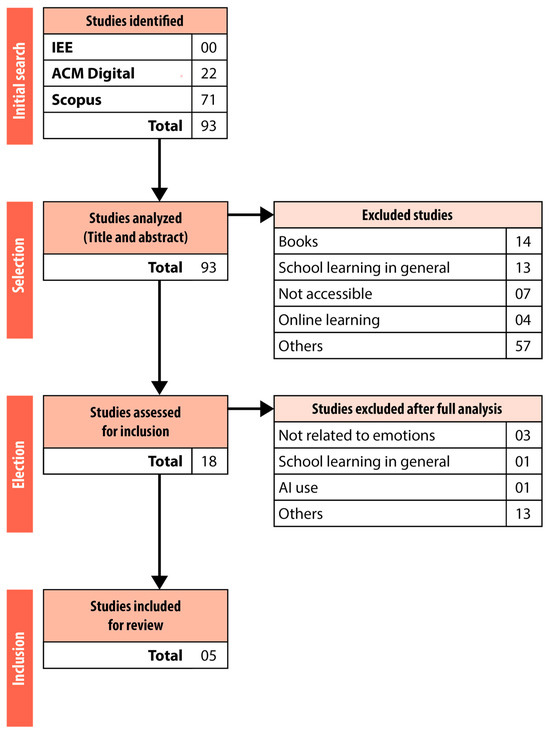
Figure 1
Open AccessArticle
The Implementation of the Askisi-SD Neuropsychological Web-Based Screener: A Battery of Tasks for Screening Cognitive and Spelling Deficits of Children
by
Nikolaos C. Zygouris, Eugenia I. Toki, Filippos Vlachos, Stefanos K. Styliaras and Nikos Tziritas
Educ. Sci. 2025, 15(4), 452; https://doi.org/10.3390/educsci15040452 (registering DOI) - 5 Apr 2025
Abstract
The Askisi-Spelling Deficits (SD) neuropsychological web-based screener was developed to assess cognitive and spelling abilities in children, with an emphasis on the early detection of spelling disorders. This tool incorporates six tasks that evaluate cognitive domains, such as visual and auditory working memory,
[...] Read more.
The Askisi-Spelling Deficits (SD) neuropsychological web-based screener was developed to assess cognitive and spelling abilities in children, with an emphasis on the early detection of spelling disorders. This tool incorporates six tasks that evaluate cognitive domains, such as visual and auditory working memory, response inhibition, and spelling processing, providing a comprehensive framework for assessment. A study conducted with 264 Greek children, including 132 children with spelling deficits and 132 typically developing controls, aimed to implement this screening tool. Results indicated that the screener was effective, as children with spelling deficits showed significantly lower performance and longer response times across all tasks. The tool’s internal consistency was supported by split-half correlations (r = 0.64) and Spearman–Brown coefficients (r = 0.78). Nonetheless, certain limitations were identified, including the absence of latency data for specific tasks (Go/No-Go and working memory), as well as the screener’s cultural specificity, which might limit its applicability to other linguistic and orthographic systems. Future iterations should prioritize the inclusion of timing mechanisms for more detailed assessments and consider adaptations for use in languages with varying orthographic complexities. Expanding the demographic reach and conducting longitudinal validation studies would further improve its utility and generalizability. The web-based nature of the screener enables scalable and standardized administration, making it a practical and efficient tool for the early identification of spelling difficulties in children.
Full article
(This article belongs to the Section Special and Inclusive Education)
►▼
Show Figures

Figure 1
Open AccessReview
Individual and Organizational Variables in Job Satisfaction of First- to Ninth-Grade Teachers: A Preferred Reporting Items for Systematic Reviews and Meta-Analyses-Guided Scoping Review
by
Raiany Poloni, Célia Oliveira and João Lopes
Educ. Sci. 2025, 15(4), 451; https://doi.org/10.3390/educsci15040451 (registering DOI) - 5 Apr 2025
Abstract
►▼
Show Figures
(1) Background: Teacher job satisfaction is critical to a school’s organizational development and students’ academic success. This study investigates the job satisfaction of first- to ninth-grade teachers, focusing on the individual and organizational variables that influence and explain this phenomenon. (2) Methods: A
[...] Read more.
(1) Background: Teacher job satisfaction is critical to a school’s organizational development and students’ academic success. This study investigates the job satisfaction of first- to ninth-grade teachers, focusing on the individual and organizational variables that influence and explain this phenomenon. (2) Methods: A systematic review was conducted following the Preferred Reporting Items for Systematic Reviews and Meta-Analyses extension for Scoping Reviews (PRISMA-ScR) guidelines, analyzing studies published between 2017 and 2022 in the Scopus, ERIC, and SciELO databases. A total of 32 studies were included in the review. (3) Results: The results indicate that demographic variables (33.5%) are the most frequently examined at the individual level concerning teacher job satisfaction. At the organizational level, variables associated with school principals are the most prominently represented (12%). (4) Conclusions: This review identifies a significant gap in the literature, with limited attention to individual and organizational variables. This finding underscores the need for further research on emerging factors, such as the impact of administrative burdens on teacher satisfaction. Additionally, this study highlights the importance of accounting for different countries’ socio-cultural and institutional contexts when exploring factors that influence teacher job satisfaction.
Full article
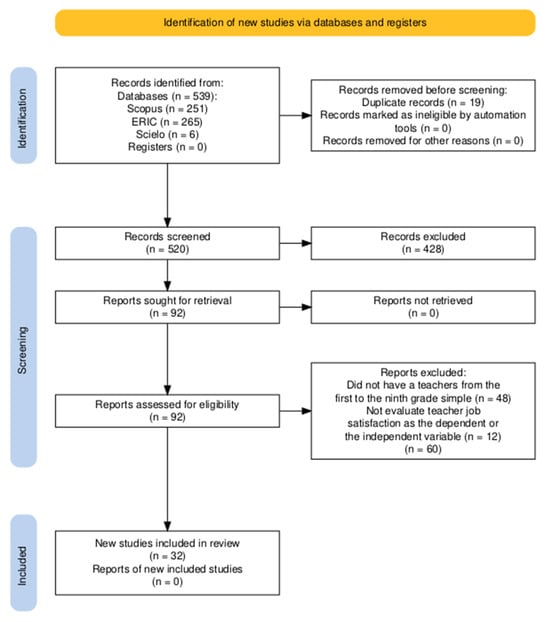
Figure 1
Open AccessArticle
Tech-Enhanced Vocabulary Acquisition: Exploring the Use of Student-Created Video Learning Materials in the Tertiary-Level EFL (English as a Foreign Language) Flipped Classroom
by
Jelena Bobkina, Svetlana Baluyan and Elena Dominguez Romero
Educ. Sci. 2025, 15(4), 450; https://doi.org/10.3390/educsci15040450 (registering DOI) - 5 Apr 2025
Abstract
This study explores the effectiveness of Technology-Assisted Vocabulary Learning (TAVL) using student-created video learning materials within a tertiary-level English as a Foreign Language (EFL) flipped classroom. By leveraging the flipped classroom model, which allocates classroom time for interactive activities and shifts instructional content
[...] Read more.
This study explores the effectiveness of Technology-Assisted Vocabulary Learning (TAVL) using student-created video learning materials within a tertiary-level English as a Foreign Language (EFL) flipped classroom. By leveraging the flipped classroom model, which allocates classroom time for interactive activities and shifts instructional content delivery outside of class, the research investigates how student-produced videos can enhance vocabulary acquisition and retention. Conducted with 47 university students from a Translation and Translation Studies course, the study aims to fill a gap in empirical evidence regarding this innovative approach. Quantitative analysis revealed that students who created and utilized videos (Group 1) showed the highest improvement in vocabulary scores, followed by those who only used the videos (Group 2), with the control group relying on traditional teacher-led methods showing the least improvement. Qualitative feedback highlighted that video creators experienced deeper engagement and better vocabulary retention, while users appreciated the videos’ visual and auditory elements but faced challenges with vocabulary overload. The findings suggest that incorporating student-created videos into the curriculum fosters a dynamic and collaborative learning environment, offering practical implications for enhancing vocabulary instruction through technology-enhanced pedagogical practices. Future research should focus on optimizing video production processes and integrating these methods with traditional teaching for comprehensive vocabulary learning.
Full article
(This article belongs to the Section Language and Literacy Education)
Open AccessArticle
The Impact of the COVID-19 Pandemic upon Mathematics Assessment in Higher Education
by
Eabhnat Ní Fhloinn and Olivia Fitzmaurice
Educ. Sci. 2025, 15(4), 449; https://doi.org/10.3390/educsci15040449 - 3 Apr 2025
Abstract
Historically, the assessment of mathematics in higher education comprised closed-book, summative, proctored examinations. Related disciplines and subjects like statistics, mathematics education, and the history of mathematics lend themselves to a broader range of assessment techniques that have been reported to provide a more
[...] Read more.
Historically, the assessment of mathematics in higher education comprised closed-book, summative, proctored examinations. Related disciplines and subjects like statistics, mathematics education, and the history of mathematics lend themselves to a broader range of assessment techniques that have been reported to provide a more balanced picture of students’ abilities. In 2020, an online environment for the teaching and learning of mathematics was imposed on the academic world globally as a result of the COVID-19 pandemic. In an effort to teach and assess remotely while maintaining institutional academic standards, the majority of lecturers were in a situation where closed-book, proctored assessments were not an option. As a result, other methods were adopted. This paper reports on an investigation into how mathematics lecturers worldwide assessed mathematics before the pandemic, during the initial lockdown restrictions, and in the immediate aftermath, while some restrictions were still in place, to see if any changes were sustained. There was a statistically significant difference in the proportion of respondents who used many of the assessment types investigated across the three time periods, including open-book timed, open-book untimed, closed-book, multiple-choice questions, online proctored, in-person proctored, presentations, projects, and assignments. The majority of those who favoured closed-book proctored examinations prior to the pandemic moved to timed open-book assessments. Differences between the weightings of final examinations versus continuous assessments were also statistically significant, with greater weight given to continuous assessment once the pandemic began. Respondents’ satisfaction levels with their assessments were significantly different also, with the highest satisfaction levels prior to the pandemic and the lowest during the initial lockdown restrictions. Academic integrity was a key concern of the majority of respondents when assessing the learning outcomes of their modules and played a role in the vehicle of assessment they chose.
Full article
(This article belongs to the Special Issue Innovations in Mathematics Education: Evaluation, Research and Practice)
►▼
Show Figures

Figure 1
Open AccessArticle
The Impact of Integrated Project-Based Learning and Flipped Classroom on Students’ Computational Thinking Skills: Embedded Mixed Methods
by
Muh Fitrah, Anastasia Sofroniou, Caly Setiawan, Widihastuti Widihastuti, Novi Yarmanetti, Melinda Puspita Sari Jaya, Jontas Gayuh Panuntun, Arfaton Arfaton, Septrisno Beteno and Ika Susianti
Educ. Sci. 2025, 15(4), 448; https://doi.org/10.3390/educsci15040448 - 2 Apr 2025
Abstract
Computational thinking skills among high school students have become a global concern, especially in the context of the ever-evolving digital education era. However, the attention given by teachers to this skill during mathematics instruction has not been a priority. This study aims to
[...] Read more.
Computational thinking skills among high school students have become a global concern, especially in the context of the ever-evolving digital education era. However, the attention given by teachers to this skill during mathematics instruction has not been a priority. This study aims to evaluate and explore the impact of project-based learning (PBL) integrated with flipped classroom on high school students’ computational thinking skills in mathematics. The research design employed a mixed-method approach with a quasi-experimental, nonequivalent pre-test post-test control group design. The experimental group (46 students) and control group (45 students) were selected through simple random sampling from 12th-grade science students. Data were collected through tests, questionnaires, and in-depth interviews, using instruments such as computational thinking skills assessment questions, questionnaires, and interview protocols. Quantitative data analysis was performed using SPSS Version 26 for t-tests and ANOVA, while qualitative analysis was conducted using ATLAS.ti with an abductive-inductive and thematic approach. The findings indicate that PBL integrated with flipped classrooms significantly improved students’ decomposition, pattern recognition, and abstraction skills. The implementation of PBL, integrated with a flipped classroom, created an interactive learning environment, fostering active engagement and enhancing students’ understanding and skills in solving mathematical concepts. Although there was an improvement in algorithmic thinking skills, some students still faced difficulties in developing systematic solutions. The results of this study suggest that further research could explore other methodologies, such as grounded theory and case studies integrated with e-learning, and emphasize visual analysis methods, such as using photo elicitation to explore thinking skills.
Full article
(This article belongs to the Special Issue Project-Based Learning in Integrated STEM Education)
►▼
Show Figures

Figure 1
Open AccessArticle
Teaching Justice-Oriented Picturebooks Through Collaborative Discussion and ‘Slow Looking’: Implications for Initial Teacher Education Settings
by
Angie Zapata, Sarah Reid and Mary Adu-Gyamfi
Educ. Sci. 2025, 15(4), 447; https://doi.org/10.3390/educsci15040447 - 2 Apr 2025
Abstract
Picturebooks have a long history as literature for literacy learning in initial teacher education (ITE) settings. Yet, the practice of “using” picturebooks solely to teach isolated skills becomes more alarming as pre-service teachers encounter classroom picturebook instruction that features diverse racial, linguistic, or
[...] Read more.
Picturebooks have a long history as literature for literacy learning in initial teacher education (ITE) settings. Yet, the practice of “using” picturebooks solely to teach isolated skills becomes more alarming as pre-service teachers encounter classroom picturebook instruction that features diverse racial, linguistic, or ethnic communities as “plugged” into scripted curriculum without opportunities for students to respond to the socio-cultural portrayals encountered. Guidance for ITE programs is needed to ensure that the aesthetic and sociopolitical features of picturebooks are not only considered but deeply taught to pre-service teachers. Drawing from a qualitative analysis of a fifth-grade reader engaging with a picturebook featuring a character with a similar phenotype across ten days, an inductive and iterative process of data analysis identified salient moments of collaborative discussions and the ‘slow looking’ approaches she used to interact with justice-oriented picturebooks. Our findings highlight the visual, material, and multimodal ways these texts serve as mentor resources for writing and drawing, while also acting as identity-affirming texts. To conclude, we offer essential implications for ITE settings, instructors, and their students by unpacking the significance of instruction that matters most for supporting pre-service teachers as curators of justice-oriented picturebooks.
Full article
(This article belongs to the Special Issue Inspiring Engagement through Reading and Writing with Children’s Literature in Initial Teacher Education)
►▼
Show Figures

Figure 1
Open AccessArticle
Addressing Humanities Pre-Service and In-Service Teachers’ Concerns in Integrating STEM Education—A Case Study of Geography Education
by
Sung Ho Cheuk and Yun Fat Lam
Educ. Sci. 2025, 15(4), 446; https://doi.org/10.3390/educsci15040446 - 1 Apr 2025
Abstract
STEAM education has become a global agenda to integrate humanities subjects with STEM elements. With a lack of science-related teacher training, promoting STEM education under humanities curriculums faces challenges. However, limited research has been conducted to understand the concerns of humanities teachers in
[...] Read more.
STEAM education has become a global agenda to integrate humanities subjects with STEM elements. With a lack of science-related teacher training, promoting STEM education under humanities curriculums faces challenges. However, limited research has been conducted to understand the concerns of humanities teachers in applying STEM education in their classrooms. In this study, we examined the concerns of pre-service and in-service geography (GEOG) teachers (N = 49) in Hong Kong (HK) secondary schools and evaluated the effectiveness of trainer workshops in alleviating their concerns. We applied an in-depth questionnaire analysis based on a 5-point Likert scale under a “Stages of Concern” model. The ordinal regression and t-test results suggested that (1) the pre-service and in-service GEOG teachers were highly concerned in most of the stages of concerns (Mean = 4.06/5); (2) unique yet different concerns about GEOG STEM education were identified from the pre-service teachers and in-service teachers; (3) teacher training workshops that offer scientific and STEM training could be effective in addressing the concerns of in-service teachers. As such, this study supports the development of geography STEM education and promotes the education community’s ability to address teachers’ concerns in embracing STEM education.
Full article
(This article belongs to the Special Issue STEM, Arts, and Special Education: Teacher Education Partnerships and Professional Development)
►▼
Show Figures

Figure 1
Open AccessArticle
Peer Coaching to Reflect on Digital Games in Geography Lessons During the Debriefing
by
Geraldine Baßeng and Alexandra Budke
Educ. Sci. 2025, 15(4), 445; https://doi.org/10.3390/educsci15040445 - 1 Apr 2025
Abstract
The present study investigates the influence of peer coaching on the depth of reflection on the content of digital games in geography education. The results show that the combination of a reflection diary and reflection coaching in the debriefing session significantly increases the
[...] Read more.
The present study investigates the influence of peer coaching on the depth of reflection on the content of digital games in geography education. The results show that the combination of a reflection diary and reflection coaching in the debriefing session significantly increases the depth of reflection at different levels. In particular, students were able to formulate more precise and critical statements at the level of comparison between the game world and reality, as well as at the level of self-reflection. Working in tandem and targeted questions from the trainers proved to be key success factors in promoting depth of reflection. The study shows the importance of combining written and oral reflection after using digital games and provides impetus for integrating digital games and reflection methods into the classroom.
Full article
(This article belongs to the Section Teacher Education)
►▼
Show Figures

Figure 1
Open AccessArticle
Equity-Focused, Rubric-Based Coaching: An Incremental Improvement Approach to Supporting Teachers to Shift Toward More Equitable Mathematics Instruction
by
Erica Litke, Jonee Wilson and Heather C. Hill
Educ. Sci. 2025, 15(4), 444; https://doi.org/10.3390/educsci15040444 - 1 Apr 2025
Abstract
Historically, inequities in mathematics education have resulted in mathematics classrooms that do not support all students, and particularly students from marginalized backgrounds. Efforts to transform mathematics classrooms to be culturally responsive, sustaining, and justice-oriented have met limited success at scale. It may be
[...] Read more.
Historically, inequities in mathematics education have resulted in mathematics classrooms that do not support all students, and particularly students from marginalized backgrounds. Efforts to transform mathematics classrooms to be culturally responsive, sustaining, and justice-oriented have met limited success at scale. It may be that supporting teachers to develop more equitable teaching practices would benefit from a more incremental improvement approach. This article considers how school-based mathematics coaches can support teachers to make incremental shifts toward more equitable instruction. We describe a coaching model designed to include elements of incremental improvement, in which coaches and teachers analyze video against a set of rubrics that delineate equitable teaching practices. Using established routines and structures, coaches and teachers work together to identify and enact small, actionable changes that build toward more ambitious equity-oriented practices. Drawing on pilot data, we articulate how the coaching model both reflects and builds on an improvement approach to professional learning. We argue that while incremental shifts may be insufficient to fully address systemic inequities, they can serve as a meaningful bridge toward larger changes. We conclude with considerations for engaging in equity-oriented incremental improvement work.
Full article
(This article belongs to the Special Issue Incremental and Innovative Approaches to Professional Development for Mathematics Teachers)
►▼
Show Figures

Figure 1
Open AccessArticle
Preservice Teachers’ Beliefs About Creative Teachers and Good Teachers
by
Qianyi Gao and Meihua Qian
Educ. Sci. 2025, 15(4), 443; https://doi.org/10.3390/educsci15040443 - 1 Apr 2025
Abstract
Preservice teachers’ beliefs play an important role in shaping their future instructional practices. While creativity is increasingly recognized as a key element in education, little is known about how preservice teachers perceive creative versus good teachers. The current study explored preservice teachers’ views
[...] Read more.
Preservice teachers’ beliefs play an important role in shaping their future instructional practices. While creativity is increasingly recognized as a key element in education, little is known about how preservice teachers perceive creative versus good teachers. The current study explored preservice teachers’ views on the characteristics associated with creative and good teachers, identifying both shared and unique attributes. A total of 438 preservice teachers participated in this study. The results revealed that preservice teachers value relationship building, professional competence, and creativity in both categories. Notably, the emphasis on creativity in both creative and good teachers suggests an evolving perspective on teaching that highlights the significance of fostering creativity in classrooms. Additionally, good teachers were associated with a wider range of social and personality traits, whereas creative teachers were characterized by a stronger focus on adaptability and leadership. The findings underscore the need for teacher education programs to adopt an integrative approach that values both teaching effectiveness and creativity, ensuring that future educators are well-prepared to meet the demands of 21st-century education.
Full article
(This article belongs to the Special Issue Education for Early Career Teachers)
►▼
Show Figures

Figure 1
Open AccessArticle
A Comparative Analysis of Preservice Teachers’ Knowledge of Reading Instruction and Their Confidence in Supporting Struggling Readers: A Study of India and England
by
Johny Daniel, Radhika Misquitta and Sophie Nelson
Educ. Sci. 2025, 15(4), 442; https://doi.org/10.3390/educsci15040442 - 1 Apr 2025
Abstract
This study examines the knowledge and preparedness of preservice teachers in India and England regarding the teaching of foundational reading skills. Recognising the critical role of teachers in preventing reading difficulties through explicit instruction in phonics, vocabulary knowledge, and reading comprehension strategies, we
[...] Read more.
This study examines the knowledge and preparedness of preservice teachers in India and England regarding the teaching of foundational reading skills. Recognising the critical role of teachers in preventing reading difficulties through explicit instruction in phonics, vocabulary knowledge, and reading comprehension strategies, we aimed to compare preservice teachers’ knowledge in these areas between the two countries. A survey was developed for this study and administered to preservice teachers enrolled in teacher education programs in India and England. The survey assessed their phonics knowledge, pedagogical practices across key reading domains, and confidence in supporting students with reading difficulties in inclusive classrooms. Descriptive analyses indicated that English preservice teachers demonstrated greater familiarity with phonics knowledge and were better prepared in pedagogical practices, particularly in phonics instruction, phonological awareness, and reading fluency. Both groups showed low preparedness in teaching vocabulary knowledge. Notably, Indian preservice teachers reported higher confidence levels in supporting students with reading difficulties despite lower performance in knowledge assessments. These findings suggest a need for enhanced focus on explicit phonics instruction in Indian teacher education programs and increased emphasis on vocabulary instruction in both countries. Implications for early childhood education policy are discussed, particularly with regards to preparing teachers to provide high-quality literacy instruction that supports children’s academic success.
Full article
(This article belongs to the Special Issue Early Childhood Education Policy: Impact on Children's Well-Being and Development)
►▼
Show Figures

Figure 1
Open AccessArticle
Feelings, Realizations, and Reflections of a Female Physical Education Teacher Confronting Experiences of Institutional(ized) Gender Inequality: An Autoethnography
by
Kathleen J. Lockyer and Daniel B. Robinson
Educ. Sci. 2025, 15(4), 441; https://doi.org/10.3390/educsci15040441 - 31 Mar 2025
Abstract
This autoethnographic study intertwines personal experience with scholarly inquiry, inviting a deep exploration of the lived experiences and realities of a female physical education (PE) teacher. Wonderings about identities, conformity to masculine norms, and proving oneself to staff and students led to a
[...] Read more.
This autoethnographic study intertwines personal experience with scholarly inquiry, inviting a deep exploration of the lived experiences and realities of a female physical education (PE) teacher. Wonderings about identities, conformity to masculine norms, and proving oneself to staff and students led to a review of relevant literature, journal entries, and meaningful conversations with critical friends. Through analysis and coding of emotions and reoccurring events, five themes emerged: male teaching partners and colleagues; student interactions; interactions with parents; administrative and peer support; and outside organizations. The results acknowledge the intricate interplay between self, society, PE environments, and culture. It is our hope that these reflections and realizations will connect with other women (and men) in the PE field and ignite further contemplation, conversation, and action. This, with the goal of contributing to necessary efforts to strive towards more inclusive and empowering experiences for female PE teachers.
Full article
(This article belongs to the Special Issue Empowering the Next Generation: Fostering Physical Education through Effective Pedagogy)
Open AccessProject Report
Integrating Serious Games and Gamification for Diverse Learner Groups: Lessons from the “GeoGecko” Project
by
Monika Rajcsanyi-Molnar, Istvan Andras and Sandor Czifra
Educ. Sci. 2025, 15(4), 440; https://doi.org/10.3390/educsci15040440 - 31 Mar 2025
Abstract
The “GeoGecko” project stands as an innovative effort in both technical and educational advancements, focusing on creating educational materials grounded in experiential learning principles with a strong gamification framework. This report provides a detailed account of the project’s development, leveraging e-learning components to
[...] Read more.
The “GeoGecko” project stands as an innovative effort in both technical and educational advancements, focusing on creating educational materials grounded in experiential learning principles with a strong gamification framework. This report provides a detailed account of the project’s development, leveraging e-learning components to create an engaging and immersive online program specifically designed to meet the expectations and needs of today’s high school and university students. Through a structured methodology, the study implemented gamified learning elements to assess their effectiveness. In addition to describing the development of the project, it also examines the teaching methods applied and the outcomes observed. Drawing on feedback from learners, the report highlights the program’s practical impact, effectiveness, and the lessons learned during its implementation. Results indicate that the platform successfully enhances student motivation, with higher engagement levels observed among younger participants compared to older learners. By sharing these insights, the “GeoGecko” project aims to contribute to the growing body of knowledge on integrating serious games and gamification into education.
Full article
(This article belongs to the Section Technology Enhanced Education)
►▼
Show Figures
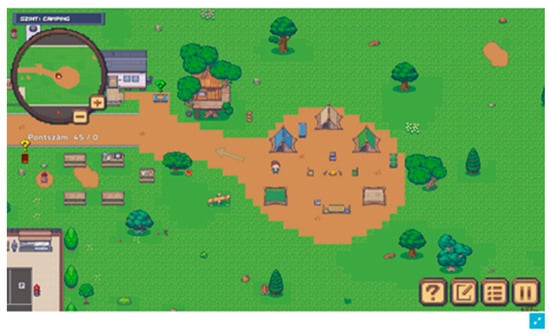
Figure 1
Open AccessArticle
Detecting Credit-Seeking Behavior with Programmed Instruction Framesets in a Formal Languages Course
by
Yusuf Elnady, Mohammed Farghally, Mostafa Mohammed and Clifford A. Shaffer
Educ. Sci. 2025, 15(4), 439; https://doi.org/10.3390/educsci15040439 - 31 Mar 2025
Abstract
When students use an online eTextbook with content and interactive graded exercises, they often display aspects of two types of behavior: credit-seeking and knowledge-seeking. A student might behave to some degree in either or both ways with given content. In this work, we
[...] Read more.
When students use an online eTextbook with content and interactive graded exercises, they often display aspects of two types of behavior: credit-seeking and knowledge-seeking. A student might behave to some degree in either or both ways with given content. In this work, we attempt to detect the degree to which either behavior takes place and investigate relationships with student performance. Our testbed is an eTextbook for teaching Formal Languages, an advanced Computer Science course. This eTextbook uses Programmed Instruction framesets (slideshows with frequent questions interspersed to keep students engaged) to deliver a significant portion of the material. We analyze session interactions to detect credit-seeking incidents in two ways. We start with an unsupervised machine learning model that clusters behavior in work sessions based on sequences of user interactions. Then, we perform a fine-grained analysis where we consider the type of each question presented within the frameset (these can be multi-choice, single-choice, or T/F questions). Our study involves 219 students, 224 framesets, and 15,521 work sessions across three semesters. We find that credit-seeking behavior is correlated with lower learning outcomes for students. We also find that the type of question is a key factor in whether students use credit-seeking behavior. The implications of our research suggest that educational software should be designed to minimize opportunities for credit-seeking behavior and promote genuine engagement with the material.
Full article
(This article belongs to the Special Issue Perspectives on Computer Science Education)
►▼
Show Figures

Figure 1
Open AccessArticle
Formative Assessment in Upper Secondary Schools: Ideas, Concepts, and Strategies
by
Davide Parmigiani, Elisabetta Nicchia, Myrna Pario, Emiliana Murgia, Chiara Silvaggio, Asia Ambrosini, Andrea Pedevilla, Ilaria Sardi and Marcea Ingersoll
Educ. Sci. 2025, 15(4), 438; https://doi.org/10.3390/educsci15040438 - 31 Mar 2025
Abstract
Recently, the European Commission issued a report on how to implement various assessment strategies in secondary schools. In particular, the Working Group on Schools emphasized the need to implement and balance assessment strategies that address both formative and summative aspects of learning. This
[...] Read more.
Recently, the European Commission issued a report on how to implement various assessment strategies in secondary schools. In particular, the Working Group on Schools emphasized the need to implement and balance assessment strategies that address both formative and summative aspects of learning. This study involves 716 Italian upper secondary teachers to highlight the ideas and concepts of formative assessment in Italian schools, to explore how teachers apply formative assessment strategies daily in their classrooms, and to understand whether formative assessment strategies support students’ learning processes. Through an analysis of quantitative and qualitative survey data collected during the school year of 2023–2024, the study explores the strategies used and strengths and weaknesses experienced by the teachers while applying formative assessment in classrooms. While the findings show that upper secondary teachers have heterogeneous and dissimilar ideas regarding formative assessments, they also indicate that using strategies based on feedback, self-assessment, Socratic methods, and metacognitive activities can foster students’ critical thinking and learning processes. Additionally, this study offers insights on how to create a meaningful link between summative and formative assessment procedures.
Full article
(This article belongs to the Section Curriculum and Instruction)
►▼
Show Figures
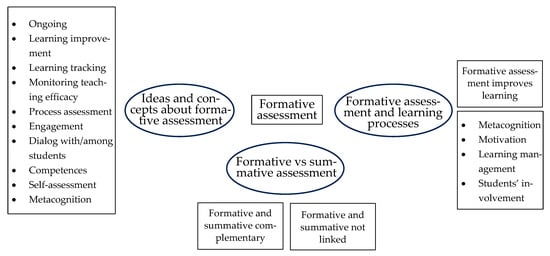
Figure 1

Journal Menu
► ▼ Journal Menu-
- Education Sciences Home
- Aims & Scope
- Editorial Board
- Topical Advisory Panel
- Instructions for Authors
- Special Issues
- Topics
- Sections & Collections
- Article Processing Charge
- Indexing & Archiving
- Editor’s Choice Articles
- Most Cited & Viewed
- Journal Statistics
- Journal History
- Journal Awards
- Society Collaborations
- Conferences
- Editorial Office
Journal Browser
► ▼ Journal BrowserHighly Accessed Articles
Latest Books
E-Mail Alert
News
Topics
Topic in
Education Sciences, Sports
Sustainability-Oriented Learning in Physical Education and Health (PEH)
Topic Editors: Suzanne Lundvall, Andreas FröbergDeadline: 15 June 2025
Topic in
AI, Applied Sciences, Education Sciences, Electronics, Information
Explainable AI in Education
Topic Editors: Guanfeng Liu, Karina Luzia, Luke Bozzetto, Tommy Yuan, Pengpeng ZhaoDeadline: 30 June 2025
Topic in
Behavioral Sciences, Brain Sciences, Children, Education Sciences
Risk and Protective Factors in Social Interactions: Behavioral and Neural Evidence
Topic Editors: Xuechen Ding, Wan Ding, Liyang SaiDeadline: 1 August 2025
Topic in
Education Sciences, EJIHPE, Sustainability, Trends in Higher Education
Education for Sustainable Development and Science Teaching
Topic Editors: José Benito Vázquez Dorrío, Araceli Queiruga-Dios, Manuel Filipe P. C. M. Costa, Miguel Ángel Queiruga DiosDeadline: 31 August 2025

Conferences
Special Issues
Special Issue in
Education Sciences
ICTs in Managing Education Environments
Guest Editors: José María Fernández-Batanero, Pedro José Arrifano Tadeu, Carlos Jorge Gonçalves BrigasDeadline: 10 April 2025
Special Issue in
Education Sciences
Unlocking Potential with Inquiry-Based Science Education
Guest Editor: Reneè SchwartzDeadline: 15 April 2025
Special Issue in
Education Sciences
Mind Matters: Exploring Mental Health and Well-Being in the Education System
Guest Editors: Till Kaiser, Christian ReintjesDeadline: 15 April 2025
Special Issue in
Education Sciences
Strategic Academic Research and Development
Guest Editors: Victor Borden, Rebecca TorstrickDeadline: 30 April 2025
Topical Collections
Topical Collection in
Education Sciences
Massive Open Online Courses
Collection Editor: Ebba Ossiannilsson
Topical Collection in
Education Sciences
Trends and Challenges in Higher Education
Collection Editors: Paul Barach, Donald A. Donahue
Topical Collection in
Education Sciences
Artificial Intelligence (AI) and Education
Collection Editors: Gary K. W. Wong, Ho-Yin Cheung






